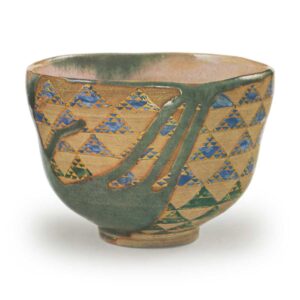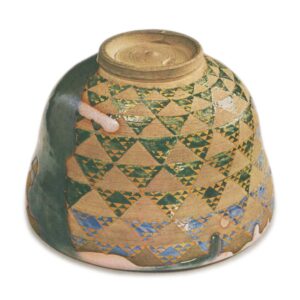

Height: 8.6 – 8.8 cm
Diameter: 12.1 – 12.4 cm
Outside diameter of foot ring: 5.0 cm
Height of foot ring: 0.7 cm
The inside of the bowl is glazed all over, while the outside is glazed in some places and left plain in others. The bowl is then fired, and the overglaze designs are painted directly onto the unglazed areas, and then fired in a separate kiln. The design of the waves, which are made to look like the rippling glaze, and the scales that cover the entire surface of the bowl, are also unique to Nisei. There are a few examples of Nisei tea bowls that use this type of technique, and those that depict the pattern of Japanese clover or iron-vine flowers are well known, but in terms of the excellence of the design, these scales and waves are in a class of their own. The tea bowl with a single wave pattern shown in this volume is also of the same type, but this one focuses on the interesting effect of the flowing glaze, and there is a difference in terms of the design effect depending on whether or not it has overglaze decoration.
The tea bowl is made from pure Shigaraki clay, which Nonomura often used, and the surface of the moderately fired clay is a refined pale grayish yellow, with a faint roughness, and the glaze has a beautiful reddish hue. As usual, the wheel-throwing is nimble and light, and the foot ring is cut with such a refreshing clarity that it takes your breath away. The body is gently constricted, and the rim of the mouth is delicately undulating. The fine details of the wheel marks, which are neatly left on the surface, are the hallmark of Nisei’s work.
The inside is covered in a translucent, smooth, milky white glaze, and the iron in the clay shows through, giving the whole a warm, light pink color. There is a single line of fire marks near the rim, and some of the white glaze has also filtered out to the outside. Then, as if to layer this, a bluish green glaze has been poured over the outside. While skillfully manipulating the bowl, he poured the glaze from the foot of the bowl towards the rim, and due to the force of the pouring, the tip of the glaze splashed into the inside of the bowl on one side, and on the other side it split into three streams, running diagonally towards the rim. This gives the appearance of the crest of a wave breaking on a thorny vine. Whether or not NINSEI had anticipated this effect is unknown, but in any case, he has created a witty design by directly applying the scale pattern to the entire surface of the unglazed body.
The so-called scale pattern, which is made up of neatly stacked triangles from the foot to the rim, is colored in a vivid ultramarine blue for the top two layers and part of the third and fourth layers, and a dark green for the rest, and small scale patterns are added in gold on each one. The shades of the ultramarine and green are subtle and uneven, and the colors are all muted and calm. The gold is not too gaudy, and the colors harmonize well with each other, beautifully enhancing the natural beauty of the clay.
The combination of the wavy green glaze and the scale pattern somewhat reminds us of the design favored by Oribe, but the scale pattern sometimes represents the scales of a dragon, and it is thought that Nisei may have intended a design with a good omen, such as a dragon and a wave. In any case, it is one of the most unique and outstanding designs among the many NINSEI tea bowls.
There is nothing in particular to mention in terms of the accompanying items, but the box is inscribed “owned by Kanamori”, so it seems that it was originally owned by Sowa Kanamori. Looking at it from this perspective, it is possible to imagine that this outstanding design may have been the result of Sowa’s direct guidance.
After that, this tea bowl passed down to the Mitsui family, and is currently in the collection of a certain Kyoto family.



